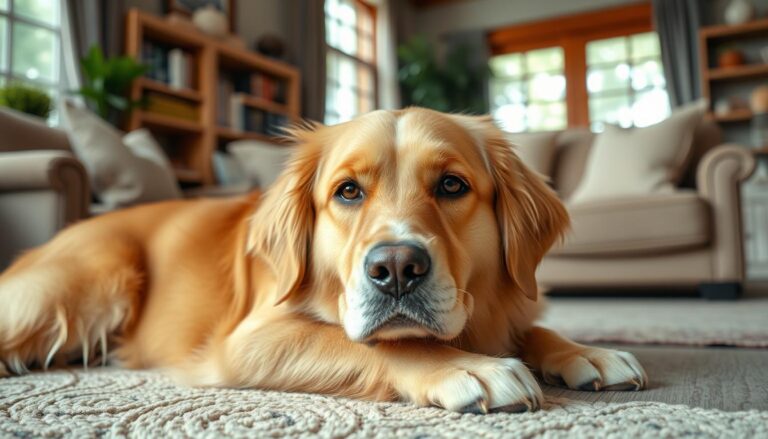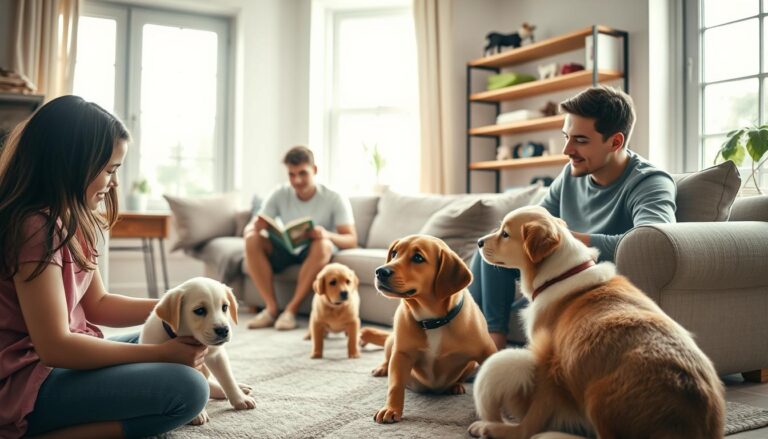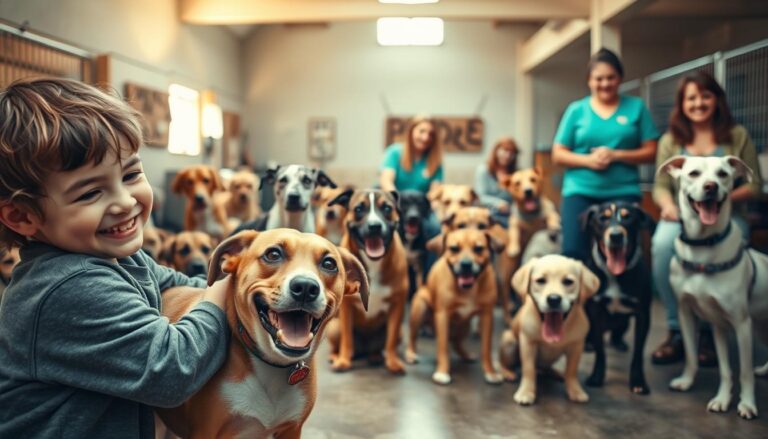Getting a rescue dog can change your life for the better. It brings joy and friendship into your home. But, your home needs to be ready for this new friend.
A ready home makes the dog feel safe and helps it adjust fast. We know adopting a rescue dog is a big step. It needs careful thought and getting ready.
By following the right steps, you can make a loving space for your pet. This article will show you the essential steps to get your home ready for a rescue dog.
It’s not just about the basics. It’s about making a home where your rescue dog feels welcome. We’ll tell you the 7 key steps to make this change easy for you and your new friend.
Key Takeaways
- Understand the needs of a rescue dog
- Create a safe and welcoming environment
- Plan for the necessary adjustments in your home
- Prepare your family for the new addition
- Learn about the importance of patience and flexibility
The Unique Needs of Rescue Dogs
Knowing what rescue dogs need is important. They might have been hurt or not cared for before. They need patience, empathy, and knowledge of rescue dog care.
Common Behavioral Challenges in Rescue Dogs
Rescue dogs face many challenges. They might be scared, have trouble with people, or not know how to use the bathroom. Seeing these challenges is the first step to helping them.
Some dogs are scared of things. They need to be slowly shown these things to feel safe. This helps them feel more confident.
| Behavioral Challenge | Possible Cause | Support Strategy |
|---|---|---|
| Fear-based behaviors | Past trauma or abuse | Gradual exposure, positive reinforcement |
| Difficulty with socialization | Lack of early socialization | Controlled social interactions, reward calm behavior |
| House training challenges | Previous living conditions | Establish a routine, praise successful attempts |
Setting Realistic Expectations for Adjustment
When you bring a rescue dog home, know it takes time for them to adjust. How long it takes depends on their past and how they feel. Being ready for this and keeping a supportive home is key.
It might take weeks or months for them to feel at home. Keep a regular routine, give them a safe place, and use positive training. Remember, it’s okay if they have setbacks. This helps you stay patient and focused on their happiness.
Step 1: Dog-Proof Your Living Space
Welcoming a rescue dog starts with making your home safe. You need to remove dangers and protect your things.
Identifying and Removing Potential Hazards
To make your home safe, first find dangers. Electrical cords and blind cords are bad if chewed.
Securing Electrical Cords and Blind Cords
Use cord protectors or hide these cords. This keeps your dog safe from shock.
Removing Toxic Plants and Chemicals
Some plants and chemicals harm dogs. Find and remove these dangers from your home.
Here’s a quick guide to toxic items for dogs:
| Toxic Substance | Found In | Precaution |
|---|---|---|
| Xylitol | Sugar-free gum, candy | Keep out of reach |
| Chocolate | Candy, baked goods | Avoid feeding |
| Cleaning Supplies | Under sink, cleaning caddy | Secure in locked cabinets |
Protecting Your Belongings
It’s important to keep your things safe with a new dog. Valuables and breakables need to be stored away.
Storing Valuables and Breakables
Put fragile items on high shelves or in locked cabinets. This stops damage.
Managing Trash and Food Access
Use dog-proof lids on trash cans. Don’t leave food where your dog can get it.
Step 2: Create a Safe Haven for Your Rescue Dog
To help your rescue dog feel at home, create a quiet, safe area. This space is like a sanctuary. It gives your dog a sense of security and comfort.
When creating a safe space for your rescue dog, think about these things:
- Find a quiet spot in your home, away from the busy areas.
- Make sure it’s quiet and free from loud noises.
- Make it easy for your dog to get to.
Setting Up a Quiet, Low-Traffic Space
The area should be calm and peaceful. This lets your dog relax without being bothered. Use calming aids like pheromone diffusers or calming music to make it even better.
Choosing Appropriate Bedding and Comfort Items
Give your dog comfy bedding and things they love, like a favorite toy or blanket. This makes the space welcoming. It helps your dog feel safe and comfortable.
By preparing this special place, you’re helping your rescue dog adjust to their new home.
Step 3: Gather Essential Supplies Before Arrival
To make your new rescue dog feel welcome, you need to get some important things first. Having the right stuff is key to making your dog’s space comfy and safe.
Food, Water, and Feeding Stations
First, get your dog the right food and water bowls. Stainless steel or ceramic bowls are best because they’re easy to clean and last long. A feeding station keeps things tidy and makes cleaning up easier. Also, remember to buy your dog’s favorite food and treats for training and rewards.
Collar, Leash, Harness, and ID Tags
You’ll need a collar, leash, and harness for safe walks. Make sure the collar fits right and has your dog’s ID tags with your contact info. A harness is great for dogs that pull, as it spreads out the force and is comfy.
Appropriate Toys for Stress Relief and Enrichment
Toys are very important for your dog’s happiness and mind. Pick toys that are tough, safe for dogs, and fit your dog’s age, size, and breed. Toys that challenge your dog, like puzzle toys, keep them busy and calm. Changing toys often keeps things interesting and prevents boredom.
| Supply | Description | Importance Level |
|---|---|---|
| Food and Water Bowls | Stainless steel or ceramic bowls for easy cleaning | High |
| Collar, Leash, and Harness | Properly fitting for safe walks and identification | High |
| Toys | Durable, dog-safe toys for stress relief and enrichment | Medium |
| Feeding Station | Organizes mealtime and simplifies cleanup | Medium |
| Dog Food and Treats | Nutritious food and healthy treats for training and rewards | High |
Step 4: Establish House Rules and Routines
When you bring home a rescue dog, setting up a daily routine is key. This routine should have clear rules and boundaries. It helps the dog feel less stressed and anxious.
Creating a routine is a two-step process. First, we make a daily schedule. Then, we decide on off-limits areas and boundaries.
Creating a Consistent Daily Schedule
A daily schedule is important for a rescue dog’s adjustment. It includes:
- Regular feeding times to prevent overeating
- Scheduled exercise and playtime to keep them active
- Designated potty breaks to housebreak the dog
- Quiet time or relaxation periods to help them unwind
This schedule helps our rescue dog feel secure and build trust.
Determining Off-Limit Areas and Boundaries
Setting off-limits areas and boundaries is crucial. It prevents bad behavior and keeps the dog safe. We should:
- Identify areas that are off-limits, like certain rooms or furniture
- Use positive reinforcement to teach the dog to respect these boundaries
- Be consistent in enforcing these rules to avoid confusion
By setting clear rules and boundaries, we help our rescue dog understand what’s expected. This makes for a happy home.
Step 5: How to Prepare Your Home for a Rescue Dog with Other Pets
When you have other pets at home, getting a rescue dog is a big step. It’s important to introduce the new dog carefully. This way, everyone can live together peacefully.
Planning Controlled Introduction Processes
Start by letting the pets get used to each other’s smells first. Then, let them see each other from a distance. Finally, meet them face-to-face in a calm place. Keep these first meetings short and happy to avoid any upset.
Temple Grandin, a famous animal expert, said, “Slow and careful steps are the secret to a good introduction.”
Creating Separate Spaces and Resources Initially
Give your new dog and the pets you already have their own spots. This means separate places for eating, sleeping, and using the bathroom. Make sure each pet has a special place to go when they feel scared or overwhelmed.
| Resource | Why Separate? | Benefit |
|---|---|---|
| Feeding Areas | Reduces competition for food | Less stress during meals |
| Beds/Litter Boxes | Provides personal space | Enhances sense of security |
By doing these things, you can make a happy home for your rescue dog and the pets you already have. This way, everyone can live together without stress.
Step 6: Prepare Family Members, Especially Children
Getting your family ready for a rescue dog is key. It makes sure the dog and your home fit well together.
Teaching Proper Interaction with Rescue Dogs
Teach kids how to be gentle and kind to the rescue dog. They need to know how to read the dog’s body language and respect its space.
Recognizing Stress Signals
Teach kids to spot when a dog is stressed. Look for growling, avoiding eye contact, or tucking their tail. This keeps everyone safe.
Respecting the Dog’s Space
It’s important to teach kids to respect the dog’s alone time. The dog needs places to rest without being bothered.
Assigning Age-Appropriate Responsibilities
Let kids help with the dog’s care. This teaches them important skills and helps the dog.
Young kids can do simple things like refilling the dog’s water bowl or helping with simple commands. Older kids can do more, like assisting with feeding or helping with grooming.
Step 7: Plan for Training and Socialization
As we get our home ready, we must plan for our rescue dog’s training and socialization. This is key for them to adjust and bond with us.
We need basic training equipment and high-value treats for positive training. Treats help motivate our dog during training.
Basic Training Equipment and High-Value Treats
Getting the right tools, like clickers and harnesses, and treats is important. They help teach good behavior and stop bad actions.
Finding Dog-Friendly Areas in Your Neighborhood
Finding places where dogs are welcome is crucial. Look for parks, trails, and pet stores that allow dogs. This helps our dog meet new friends.
Researching Force-Free Trainers for Rescue Dogs
It’s important to find force-free trainers who work with rescue dogs. They can help with behavior issues and create a training plan for our dog.
Conclusion
Preparing your home for a rescue dog is important. You need to follow 7 key steps. This makes your home welcoming for your dog.
It’s key to know how to get your home ready for a rescue dog. You should dog-proof your space and make a safe area. Also, get the right supplies and set house rules.
Teach your family about the dog and plan for training and socialization. These steps help you and your dog have a great life together.
Preparing your home well helps your dog feel less stressed. This makes the move easier for both of you. A good home is the start of a happy life together.
FAQ
What are the most common behavioral challenges in rescue dogs?
Rescue dogs may face many challenges. These include fear, separation anxiety, and aggression. We must be patient and train them properly.
How can we dog-proof our home for a rescue dog?
To dog-proof our home, we need to find and remove dangers. Secure cords and keep plants and chemicals away. Also, store valuable things where the dog can’t get them.
What essential supplies do we need before bringing a rescue dog home?
Before bringing a rescue dog home, get the basics. This includes food, water, and a collar. Also, get toys to help them relax and have fun.
How can we introduce a rescue dog to our other pets?
Introducing a rescue dog to other pets needs a plan. Start with a controlled meeting. Give them their own space and watch how they act together.
How can we prepare our children for a rescue dog?
Teach kids how to interact with the dog. Show them how to spot when the dog is stressed. Give them tasks that are just right for their age.
What are the key elements of a successful training plan for a rescue dog?
A good training plan has the right tools and treats. Find safe places for the dog to meet others. Look for trainers who know how to help rescue dogs.
How can we create a safe space for our rescue dog?
Create a quiet spot for the dog. It should have comfy bedding and things that make them feel safe. Let them go there when they feel scared or overwhelmed.
What are the benefits of establishing house rules and routines for a rescue dog?
House rules and routines help the dog feel safe. They give the dog a sense of order. This makes it easier for them to know what to do.






One Comment